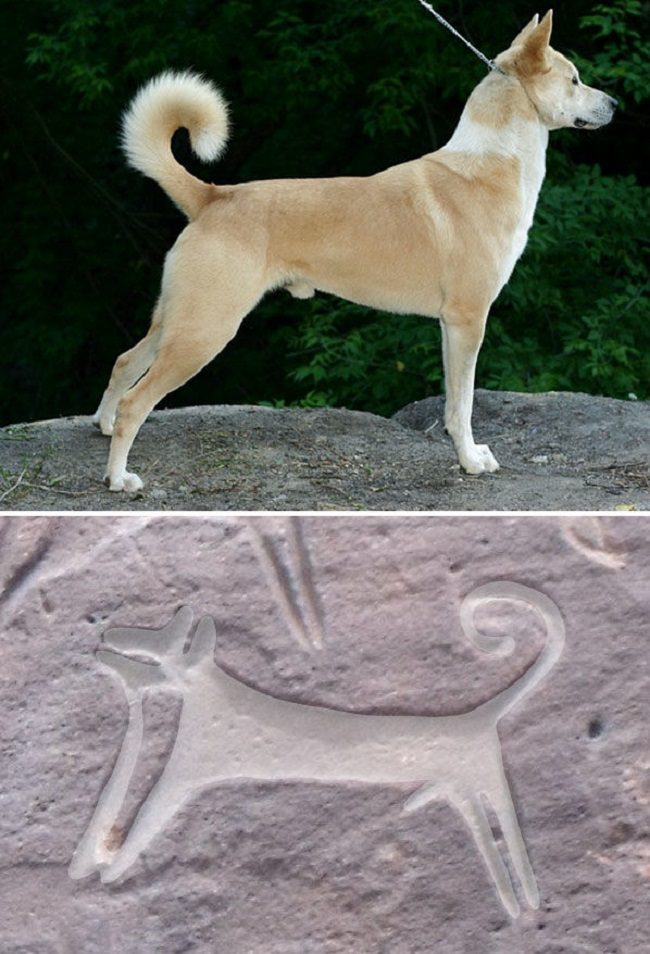
The engravings likely date back more than 8000 years, making them the earliest depictions of dogs, a new study reveals. And those lines are probably leashes, suggesting that humans mastered the art of training and controlling dogs thousands of years earlier than previously thought.
"It's truly astounding stuff," says Melinda Zeder, an archaeozoologist at the Smithsonian Institution National Museum of Natural History in Washington, D.C. "It's the only real demonstration we have of humans using early dogs to hunt." But she cautions that more work will be needed to confirm both the age and meaning of the depictions.
The hunting scene comes from Shuwaymis, a hilly region of northwestern Saudi Arabia where seasonal rains once formed rivers and supported pockets of dense vegetation. For the past 3 years, Maria Guagnin, an archaeologist at the Max Planck Institute for the Science of Human History in Jena, Germany-in partnership with the Saudi Commission for Tourism & National Heritage-has helped catalog more than 1400 rock art panels containing nearly 7000 animals and humans at Shuwaymis and Jubbah, a more open vista about 200 kilometers north that was once dotted with lakes.
Starting about 10,000 years ago, hunter-gatherers entered-or perhaps returned to-the region. What appear to be the oldest images are thought to date to this time and depict curvy women. Then about 7000 to 8000 years ago, people here became herders, based on livestock bones found at Jubbah; that's likely when pictures of cattle, sheep, and goats began to dominate the images. In between-carved on top of the women and under the livestock-are the early hunting dogs: 156 at Shuwaymis and 193 at Jubbah. All are medium-sized, with pricked up ears, short snouts, and curled tails-hallmarks of domestic canines. In some scenes, the dogs face off against wild donkeys. In others, they bite the necks and bellies of ibexes and gazelles. And in many, they are tethered to a human armed with a bow and arrow.
The researchers couldn't directly date the images, but based on the sequence of carving, the weathering of the rock, and the timing of the switch to pastoralism, "The dog art is at least 8000 to 9000 years old," Guagnin says. That may edge out depictions of dogs previously labeled the oldest, paintings on Iranian pottery dated to at most 8000 years ago.
"When Maria came to me with the rock art photos and asked me if they meant anything, I about lost my mind," says co-author Angela Perri, a zooarchaeologist at the Max Planck Institute for Evolutionary Anthropology in Leipzig, Germany. Perri has studied the bones of ancient dogs around the world, and has argued that early dogs were critical in human hunting. "A million bones won't tell me what these images are telling me," she says. "It's the closest thing you're going to get to a YouTube video."
The dogs look a lot like today's Canaan dog, says Perri, a largely feral breed that roams the deserts of the Middle East. That could indicate that these ancient people bred dogs that had already adapted to hunting in the desert, the team reports this week in the Journal of Anthropological Archaeology. Or people may even have independently domesticated these dogs from the Arabian wolf long after dogs were domesticated elsewhere, which likely happened sometime between 15,000 and 30,000 years ago.
But Zeder notes that the engravings may not be as old as they seem. To confirm the chronology, scientists will need to link the images to a well-dated archaeological site-a challenge, she says, because "the archaeological record in this region is really spotty."
Paul Tacon, an archaeologist at Griffith University in Gold Coast, Australia, agrees that "dating rock art is often a guestimate." But based on his nearly 4 decades of studying such images around the world, he says, "Their chronology is sound."
Even if the art is younger than Guagnin and her colleagues think, the leashes are by far the oldest on record. Until now, the earliest evidence for such restraints came from a wall painting in Egypt dated to about 5500 years ago, Perri says. The Arabian hunters may have used the leashes to keep valuable scent dogs close and protected, she says, or to train new dogs. Leashing dogs to the hunter's waist may have freed his hands for bow and arrow.
But Tacon cautions that the lines in the engravings could be symbolic. "It could just be a depiction of a bond." Either way, he says, that bond was clearly strong, as the artists appear to have depicted dogs they actually knew, with particular coat patterns, stances, and genders. "These creatures were very important, beloved companions."
Such a relationship would have been critical to helping people survive a harsh environment. Dogs could take down gazelles and ibexes too fast for humans, Perri says. Details of the images also suggest that the ancient hunters tailored their strategies to the landscape, Zeder says. At Shuwaymis, where the dogs may have been used to drive prey into the corners of uneven terrain, the art depicts large packs. At Jubbah, the images show smaller groups of dogs that may have ambushed prey at watering holes. "People were able to venture into these inhospitable areas by strategically marshalling dogs to survive," Zeder says. "And now we're seeing a real picture of how it happened."



But in order to receive such a privilege, one must also honor the dog as a sentient being and treat the dog as such.